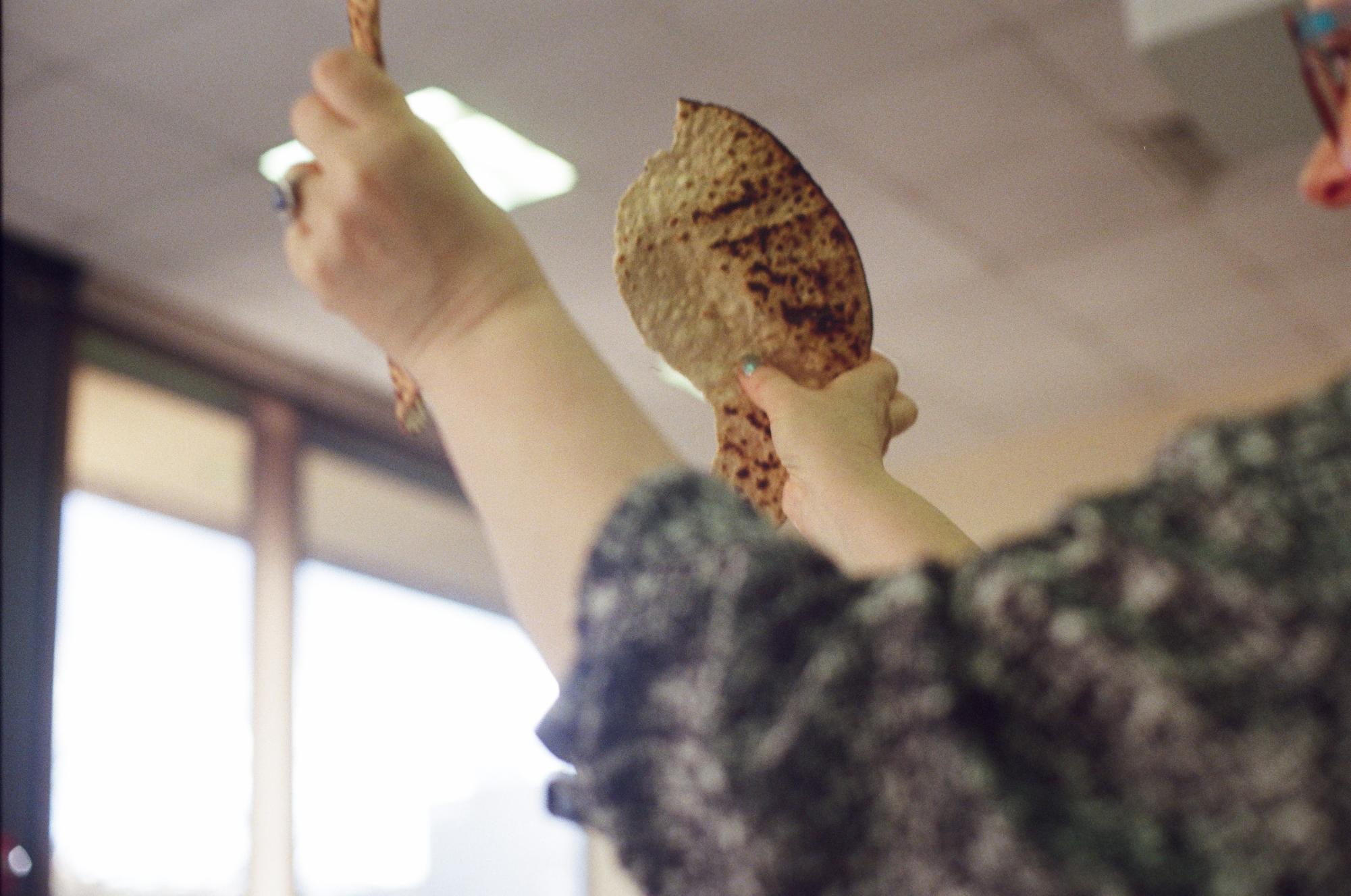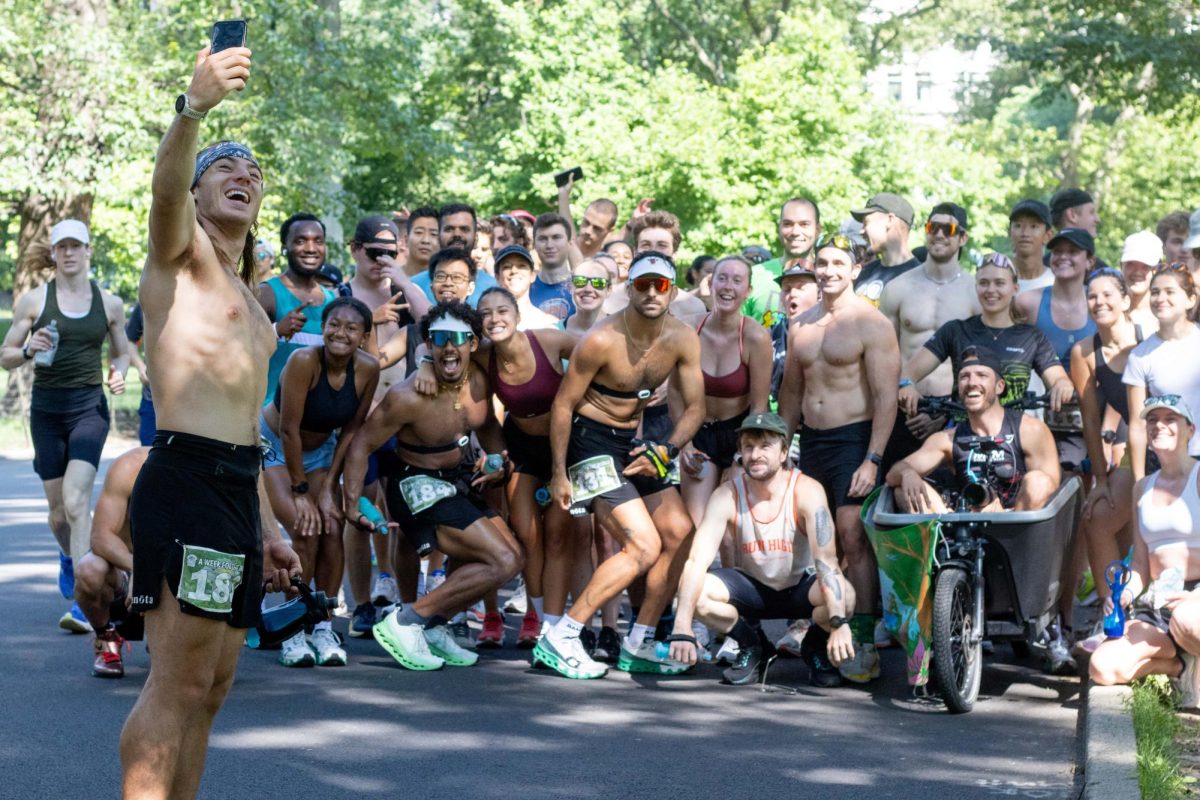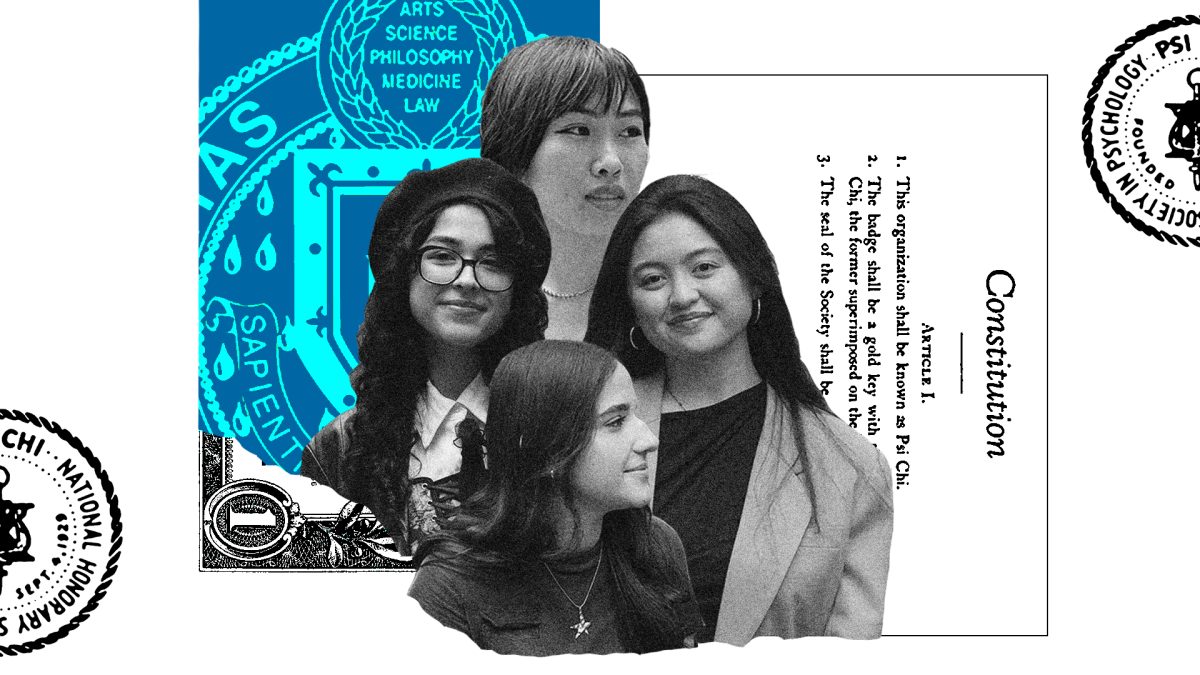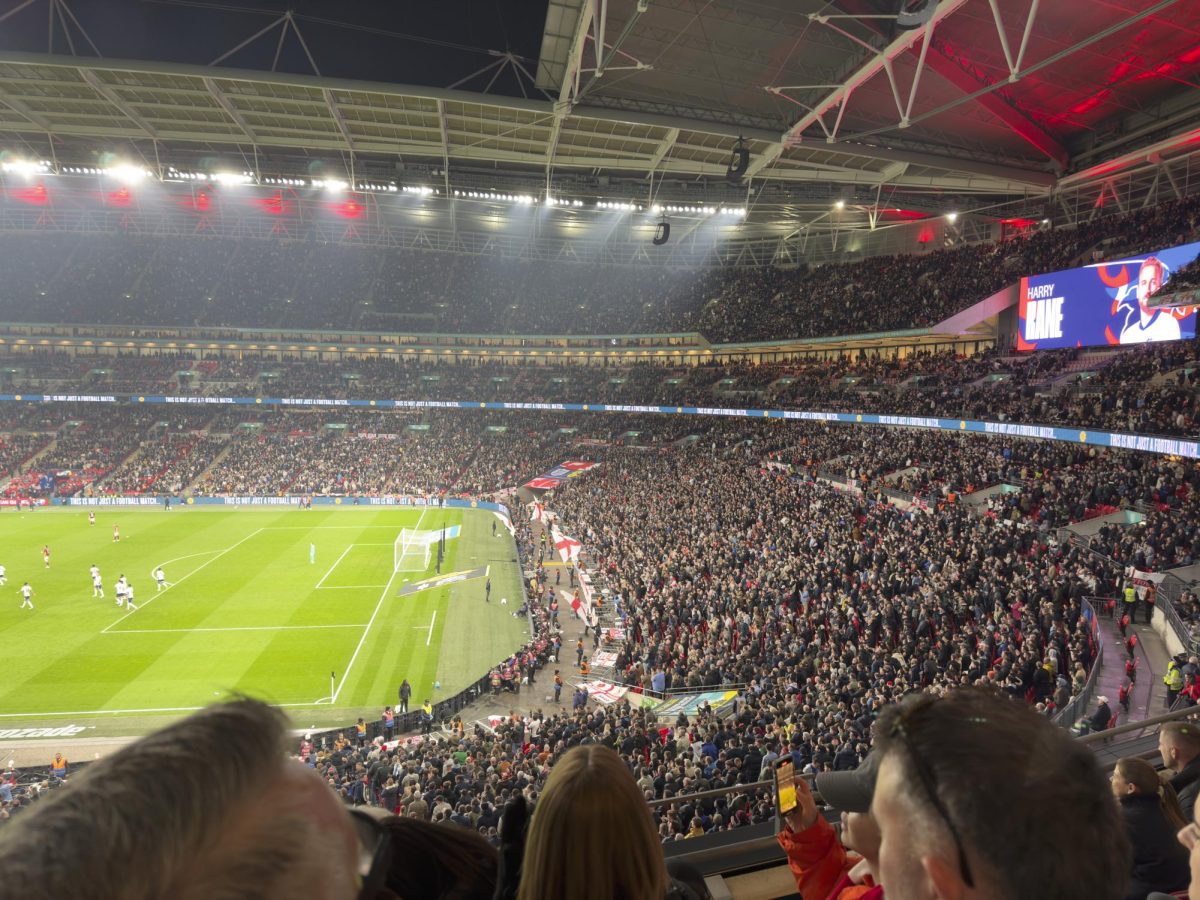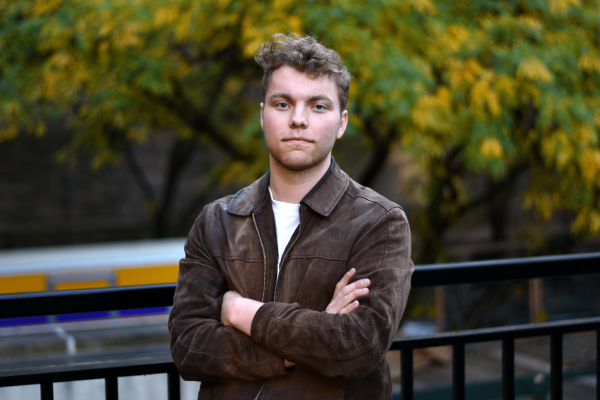On Sunday, April 13, a long, wide table in the South Lounge of Ram Café was set for a Seder dinner. The table was adorned with objects and symbols. Haggadot — books that tell the story of the Exodus from Egypt in rituals, songs, stories and prayers — were scattered about. The Seder plate, a platter of symbolic foods, sat in the middle. Matzah bread, bottles of grape juice and plates of leafy greens dotted the table. And in the center of the table, two cups: one for the prophet Elijah, and the other for the sister of Moses, Miriam.
Fordham’s inaugural Director of Jewish Life, Rabbi Katja Vehlow, welcomed the guests as they trickled into the room.
Fordham’s inaugural Director of Jewish Life, Rabbi Katja Vehlow, welcomed the guests as they trickled into the room. When the dinner was set to begin, there remained a handful of open seats at the table; however, as the event got underway, the entire table filled up, prompting the addition of another table.
This was Vehlow’s first Seder as the Director of Jewish Life at Fordham. Vehlow admitted near the end of the night that she “didn’t really know who would come and what to expect.” In total, some 20 Fordham students showed up. They took their seats and readied themselves for a night spent singing and discussing salvation.
Typically hosted on the first night of Passover, the Seder dinner is a ritual meal in the Jewish faith — one that commemorates the freedom of the Israelites from slavery in Egypt.

But before diving into the story of the Haggadah, she broke the ice by asking the table some Passover-themed would-you-rather questions.
“Would you rather battle one thousand regular frogs, or one godzilla frog?” Rabbi Katja Vehlow
“Would you rather, in four minutes, drink four cups of juice, or eat four whole pieces of Matzah — which is those things there,” she asked as she indicated a stack of unleavened bread across the table. The students called out their answers and laughed at some of the questions. “Would you rather battle one thousand regular frogs, or one godzilla frog?” Vehlow asked.
Similar to these unusual questions, Vehlow said her new position has inspired joy at Fordham.
“I think in my second or third week I went to a training session,” she explained. “I introduced myself, I’m Rabbi Katja. And people were like —” she let out a huge gasp. She said they told her, “we’re so excited you’re here!”
Soon, Vehlow began guiding the gathered students through the Haggadah, which began with Vehlow reciting the “Kiddush,” a blessing over the wine. “We’ve got to do this four times. Lots of things we’re going to do four times,” Vehlow said.
There are many theories explaining why the number four is repeated in the Haggadah, one of which Vehlow explained as corresponding to “the four descriptions of redemption that we find in the Torah.”
Vehlow read the four ways in which God promises to save the Israelites: “I will free you, I will deliver you, I will redeem you and I will take you out of Egypt,” Vehlow read.
“I made nothing here,” Vehlow said jovially. But she added that in the future, she hopes to take a more active approach to the food preparation for these kinds of holiday meals.
Then a blessing was read, followed by handwashing. Vehlow said that handwashing is a symbolic act “that people did during antiquity.” One student walked around with a pitcher of water and a bowl as each guest prepared themselves for the meal.
The food was catered by Fairway, a grocery store. “I made nothing here,” Vehlow said jovially. But she added that in the future, she hopes to take a more active approach to the food preparation for these kinds of holiday meals.
“I would like to get together and make the charoset,” she said. Charoset, she explained, is a dish that represents the mortar used by the Isrealites while enslaved in Egypt. Vehlow said that “many families and many traditions have their own recipes,” and that she would like to make the dish together as a community next year.
Vehlow led the table in the ritual of the dipping of the “karpas.” The karpas, a leafy green vegetable — in this instance, celery and parsley — is dipped into salt-water and then eaten.
Vehlow prayed over the now-soggy vegetables as everyone took a bite. “Praised are you, God, who created the fruit of the earth — this thing here,” she said. “This thing was also an appetizer in antiquity, I know it’s weird,” Vehlow smiled.
Vehlow then held up three pieces of matzah bread for all to see. “We take the one in the middle,” she explained, “and we break it.” It snapped in a crisp crack.
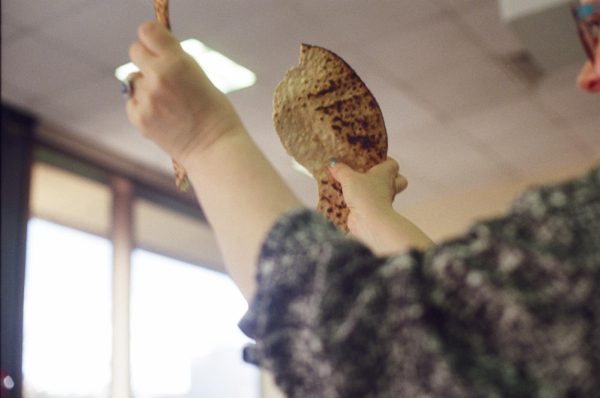
“The smaller piece stays with the others, which we’re going to eat later,” Vehlow said. She held onto the larger of the two halves, putting it in an embroidered bag. It’s a Seder tradition to hide the “afikoman,” as it’s called, for the children of the party to go and find. The special name is believed to be adapted from a Greek term designating the bread as a dessert item. One student left the room to go hide the bread somewhere in Ram Café for a search later in the night.
Vehlow encouraged everyone to take a lettuce leaf, since there were not enough spring onions, and hit their dinner companions while she sang the psalm.
Lila Herzig, Fordham College at Rose Hill (FCRH) ’25, explained that during her family’s Seder dinners, her grandfather would try to hide the afikoman without anyone noticing. “My grandfather would always sit on it and pretend that he’s magically disappeared it,” she said. “During the second hand washing, he’d go to the bathroom and wash his hands and hide it then. And then he’d do a little kind of magic reveal that the afikoman was gone.”
Vehlow led dinner guests in “Dayenu,” a song that she said is “really a psalm of gratitude.” She then instructed everyone to hit each other with spring onions, which is a Vehlow family tradition. Vehlow encouraged everyone to take a lettuce leaf, since there were not enough spring onions, and hit their dinner companions while she sang the psalm.
“Day-Dayenu / Day-Dayenu / Day-Dayenu / Dayenu Dayenu,” everyone sang as they flung lettuce leaves at each other.
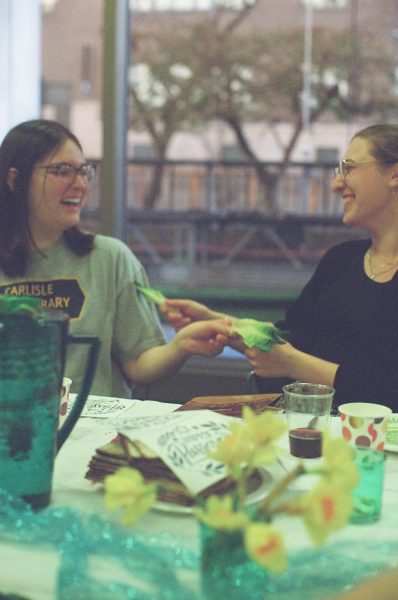
The dinner continued as trays of chicken and tubs of matzo ball soup were unveiled.
“It’s always a very joyous thing, despite it representing a lot of hardship.” Natalie Coulter, FCLC ’26
Natalie Coulter, Fordham College at Lincoln Center (FCLC) ’26, expressed what the Seder means to her.
“It’s always a very joyous thing, despite it representing a lot of hardship,” Coulter said. And, at Fordham specifically, Coulter said she hopes “Jewish students know that they have a community here.”
Vehlow ate and laughed as she talked about her favorite part of the evening. “It’s going to come in a minute when we open the door and we wait for Elijah to come. You know, the hope for redemption,” she explained. That ritual in particular, she said, is a “reminder for us that we have a job to do in this world.”
Eventually, Rabbi Vehlow said it was time to find the afikoman, and the students rushed out to Ram Café to search. Behind tables and under chairs, they looked for the embroidered bag of bread.
The night ended with a lively song, which walked through various motifs and traditions of Judaism.
One student, Grace Pak, FCLC ’27, found the afikoman rather quickly.
“I was looking up high, because the guy who hid it, he was tall,” she said. “So, I checked on top of the one vending machine, and I could see it on top of the other one.”
Pak held the bag high for all to see. Shouts of joy and surprise all mixed into one. The party moved back inside the South Lounge to share the treasure.
The night ended with a lively song, which walked through various motifs and traditions of Judaism — the Twelve Tribes of Israel, the Ten Commandments, the Six and Five books of the Mishnah and Torah, respectively, and finally, the One, “Hashem.”
“One is Hashem / One is Hashem / One is Hashem,” the table sang, “In the Heavens and the Earth.”
“It’s very exciting,” Vehlow said at the end of the night. “It’s very exciting for me to have this. And I’m looking forward to having a bigger Seder next year, and already thinking of things we can do next year.”
